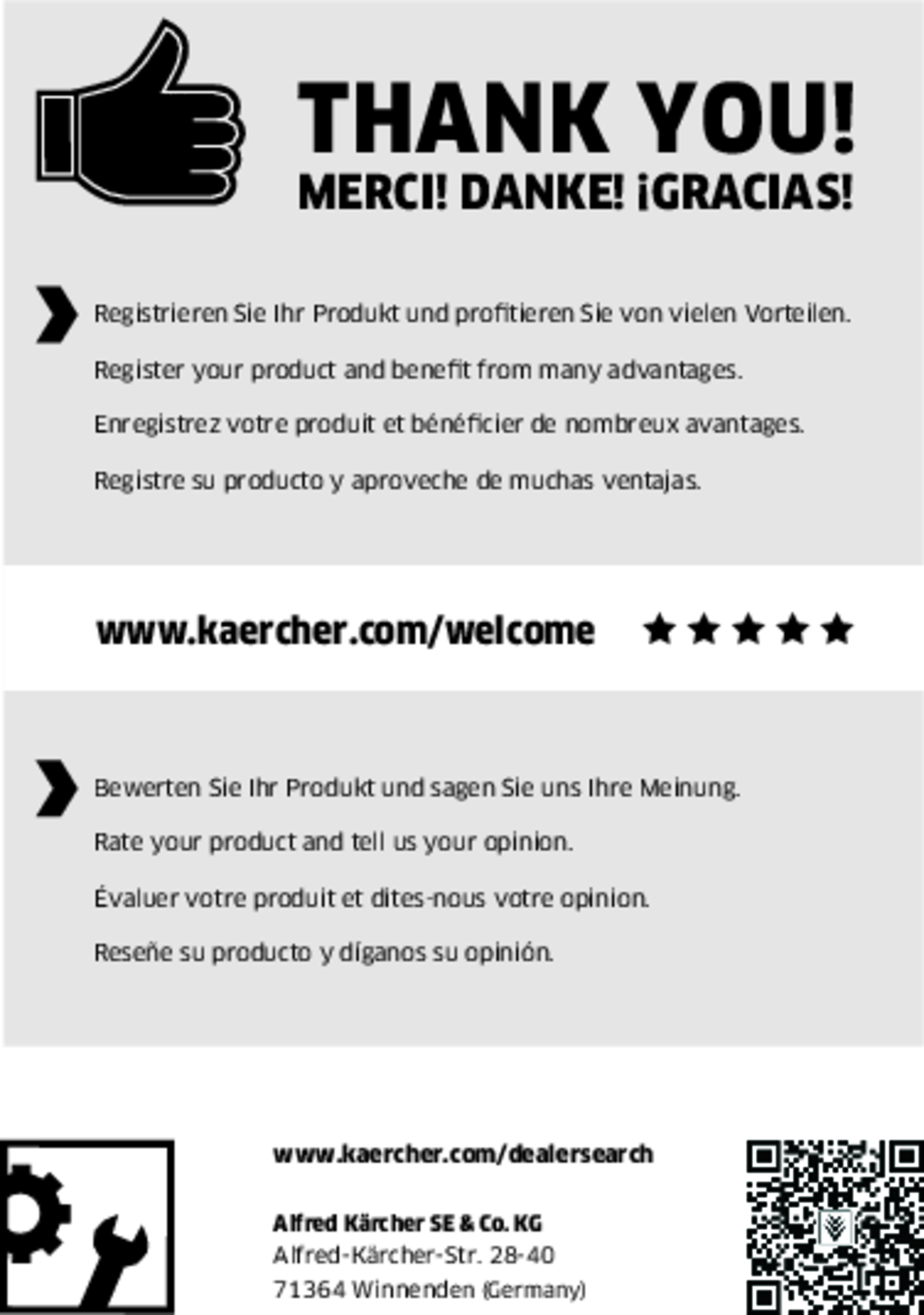B 150 RB 200 R
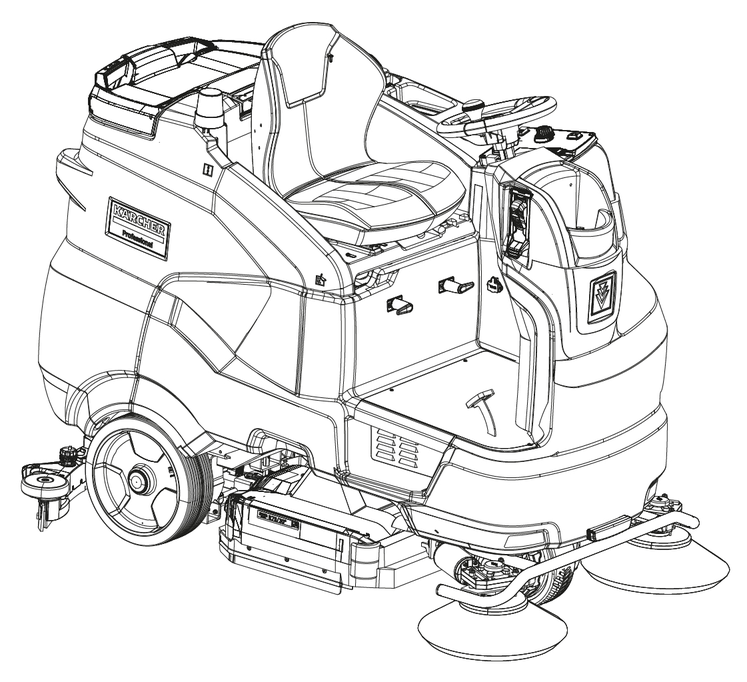
59785000 (09/21)

59785000 (09/21)
 Read these original operating instructions and the enclosed safety instructions before using the device for the first time. Proceed accordingly.
Read these original operating instructions and the enclosed safety instructions before using the device for the first time. Proceed accordingly.
Keep both books for future reference or for future owners.
This scouring and vacuum machine is used for wet cleaning or polishing of level floors.
The device can be adjusted to suit the respective cleaning task by adjusting the water quantity, detergent volume and travel speed. The detergent is dosed by adding it to the fresh water tank or via an optional dosing device (DOSE).
The device can be equipped with various accessories to suit the respective cleaning task. Request a copy of our catalogue or visit our Internet website at www.kaercher.com.
This device is suitable for commercial and industrial use, e.g. in hotels, schools, hospitals, factories, shops, offices, and rental companies. Use the device only in accordance with the information in these operating instructions.
The device may only be used for cleaning smooth surfaces that are insensitive to water and polishing.
The device is designed for indoor use.
The operational temperature range is between +5 °C and +40 °C.
The device is not suitable for cleaning frozen floors (e.g. in cold stores).
The device is suitable for a maximum water height of 1 cm. Do not drive into an area if there is a danger of exceeding the maximum water height.
When using chargers or batteries, only the components approved in the operating instructions may be used. A different combination must be confirmed by the responsible charger and/or battery supplier.
The device is not intended for cleaning public traffic routes.
The device must not be used on pressure-sensitive floors. Take into account the permissible load per unit area of the floor. The load per unit area caused by the device is specified in the technical data.
The device is not suitable for use in potentially explosive environments.
The device is approved for operation on surfaces with a maximum slope (see chapter "Technical Data").
 The packing materials can be recycled. Please dispose of packaging in accordance with the environmental regulations.
The packing materials can be recycled. Please dispose of packaging in accordance with the environmental regulations.
 Electrical and electronic devices contain valuable, recyclable materials and often components such as batteries, rechargeable batteries or oil, which - if handled or disposed of incorrectly - can pose a potential danger to human health and the environment. However, these components are required for the correct operation of the device. Devices marked by this symbol are not allowed to be disposed of together with the household rubbish.
Electrical and electronic devices contain valuable, recyclable materials and often components such as batteries, rechargeable batteries or oil, which - if handled or disposed of incorrectly - can pose a potential danger to human health and the environment. However, these components are required for the correct operation of the device. Devices marked by this symbol are not allowed to be disposed of together with the household rubbish.
Current information on content materials can be found at: www.kaercher.de/REACH
Only use original accessories and original spare parts. They ensure that the appliance will run fault-free and safely.
Information on accessories and spare parts can be found at www.kaercher.com.
Check the contents for completeness when unpacking. If any accessories are missing or in the event of any shipping damage, please notify your dealer.
Before using the device for the first time, read and observe these operating instructions and the accompanying brochure: Safety instructions for brush cleaning devices, No. 5.956-251.0.
The device is approved for operation on surfaces with a specified limited slope (see chapter "Technical Data").
The device can tip over
Risk of injury
Only operate the device on surfaces that do not exceed the permitted slope (see chapter "Technical Data").
Risk of accident due to incorrect operation
People can be injured.
Operators must be properly trained on how to use this machine.
The device may only be operated when the hood and all covers are closed.
Missing or modified safety devices!
Safety devices are provided for your own protection.
Do not bypass, remove or render ineffective any safety devices.
For immediate shutdown of all functions: Set the safety switch to "0".
The device brakes hard when the safety switch is switched off.
The safety switch acts directly on all device functions
If the operator leaves the seat during work or while driving, the seat switch switches off the engine after a short delay.
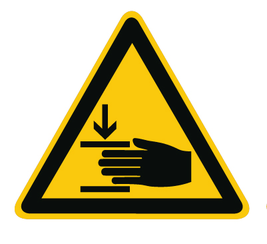
Risk of crushing
Hands can be trapped when pivoting down the waste water tank.
Do not hold any parts of your body between the tank and the device when pivoting the waste water tank down.
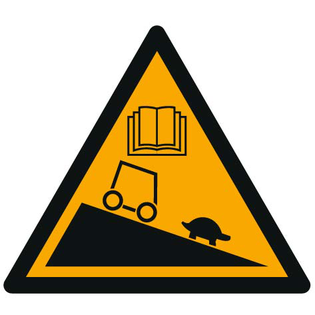
Danger of accident
On slopes, there is an increased risk of tipping over at high speed.
Drive slowly downhill.
Do not turn on a slope.
When driving fast, avoid jerky steering with a large steering angle.
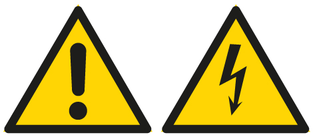
Danger of electric shock
Touching the battery poles during the charging process carries a risk of injury from high electrical voltage.
Do not remove the pole protection caps on the battery poles.
Ensure correct installation of the pole protection caps.
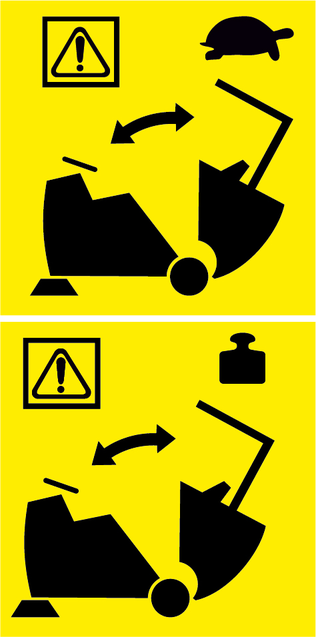
Danger of accident
The overhead guard is heavy and pulls the waste water tank backwards when pivoting.
The unit can tip over and injure persons.
Pivot the waste water tank slowly and hold it firmly to control the speed.

Crushing hazard
Strong forces act upon the waste water tank when pivoting forwards.
Make sure that there are no body parts between the waste water tank and the unit when pivoting the waste water tank forwards.
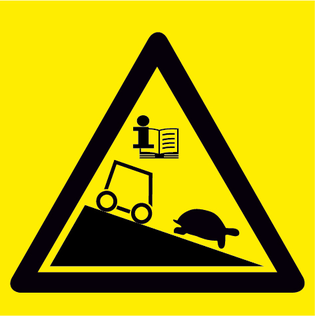
Danger of tipping over
The overhead guard increases the danger of tipping.
Drive on slopes and gradients slowly and steer carefully.
Observe the following warnings when handling the batteries:
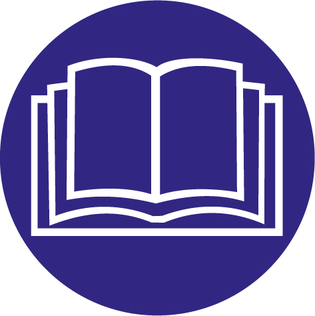 | Observe notes in the instructions for the battery, on the battery and in these operating instructions. |
 | Wear eye protection. |
 | Keep acids and batteries away from children. |
 | Risk of explosion |
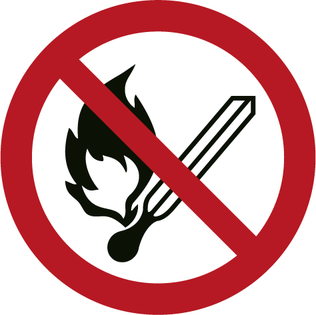 | Fire, sparks, open flames and smoking are prohibited. |
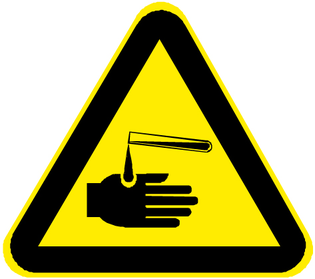 | Risk of acid burns |
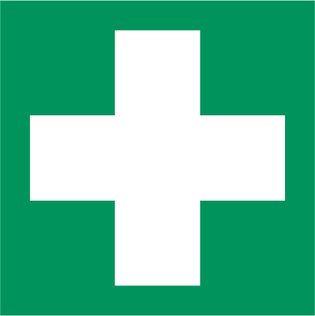 | First aid. |
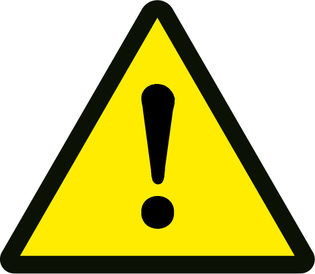 | Warning |
 | Disposal |
 | Do not throw batteries in the bin. |
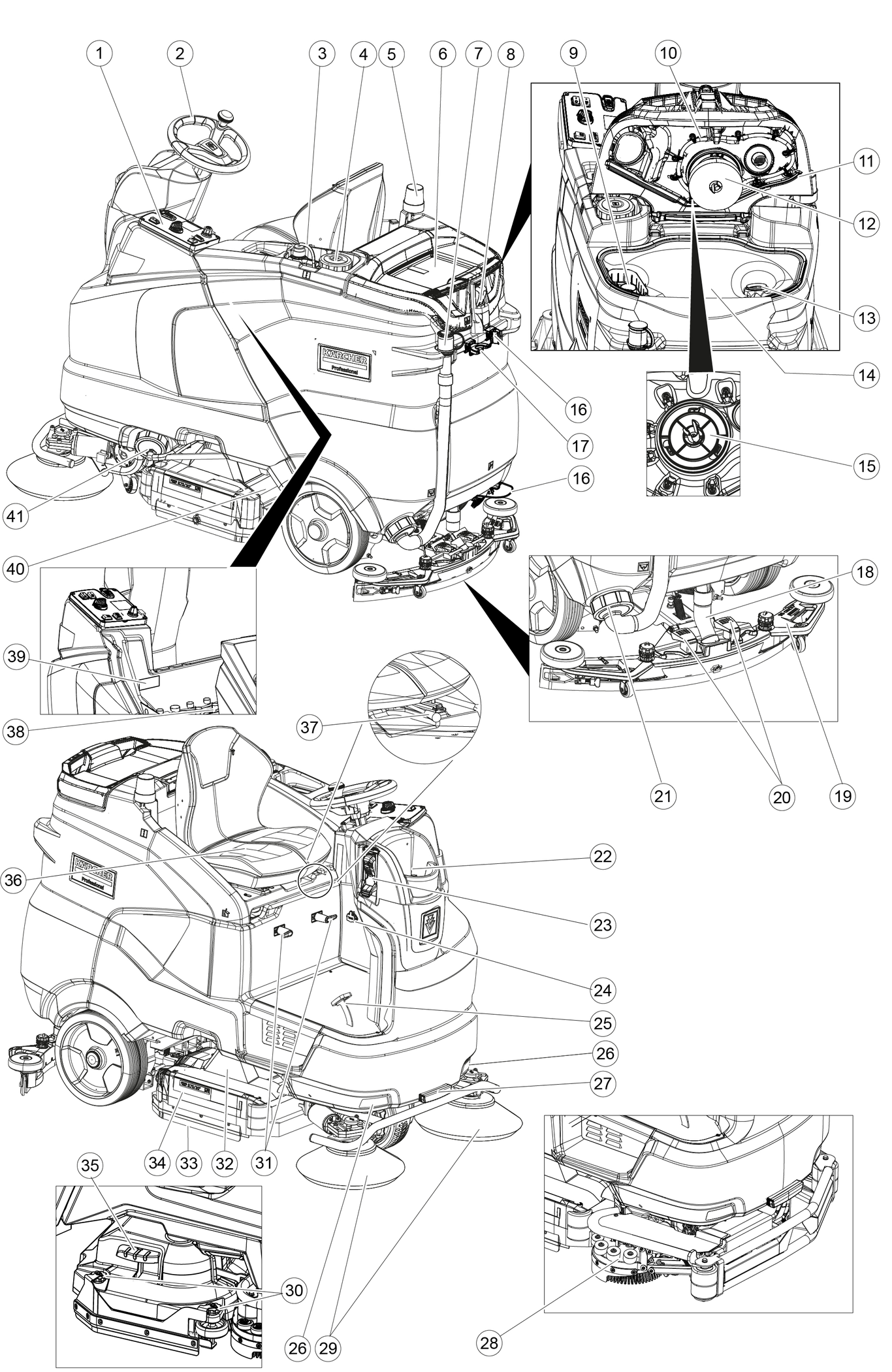
* optional
Control elements for the cleaning process are yellow.
Control elements for maintenance and servicing are light grey.
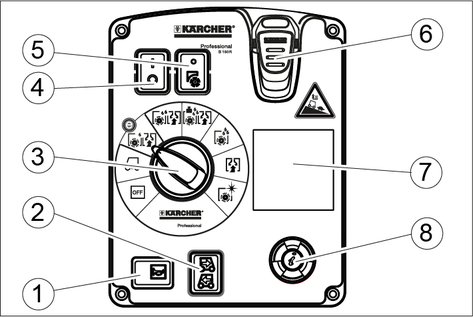
* optional
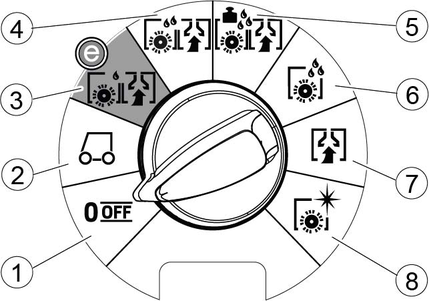
When driving through narrow spaces, the suction bar can be removed and hung in one of the openings on the lid of the waste water tank.
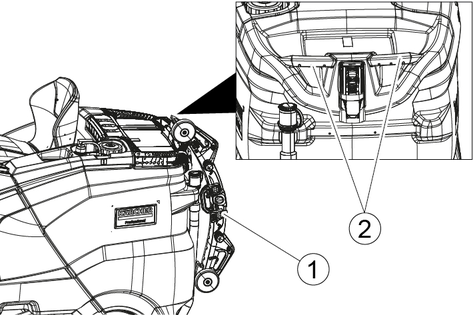
 | Handle for pivoting up the waste water tank |
 | Lashing point |
 | * Mop holder |
 | * Filling system water connection |
 | * Waste water tank flushing system water connection |
 | Fresh water tank drain opening |
 | Waste water tank drain opening |
* optional
The overhead guard protects the driver of the device from falling objects.
On devices with a overhead guard, the waste water tank is equipped with a safety lock. This safety lock prevents the waste water tank from pivoting back unintentionally through forces acting on the overhead guard.

Empty the waste water tank.
Unscrew the locking screw.
Hold the waste water tank firmly and slowly pivot it backwards.
Risk of crushing
Body parts can become trapped between the device and the waste water tank.
Make sure that there are no body parts between the device and the waste water tank when pivoting forward.
Hold the waste water tank firmly and slowly pivot it forward.
Screw in and tighten the locking screw.
Description | Order no. | Volume (m3)* | Airflow (m3/h)** |
|---|---|---|---|
Battery set 240 Ah, trough, low maintenance | 4.035-987.7 | 27 | 10.8 |
Battery set 180Ah, trough, low maintenance | 4.035-988.7 | 20.25 | 8.1 |
Battery set 240Ah, 6 blocks, maintenance-free | 4.654- 306.7 | 6.975 | 2.79 |
Battery set 180Ah, 6 blocks, maintenance-free | 4.654- 307.7 | 5.175 | 2.07 |
Battery set 285 Ah AGM | 4.654-057.7 | 8.91 | 3.56 |
Battery set 170 Ah AGM | 4.654-061.7 | 24.75 | 9.9 |
* Minimum volume of the battery charging room
** Minimum airflow between battery charging room and environment
Layout | A* | B** |
|---|---|---|
Length | 244 mm | 312 mm |
Width | 190 mm | 182 mm |
Height | 275 mm | 365 mm |
* as with 4.654-306.7
** as with 4.654-307.7
With the "Pack" variant, the batteries are already installed.
Removing and installing the batteries
Unstable machine position
Ensure that the machine is positioned stably when removing and installing the batteries.
Incorrect connection polarity
Destruction of the control electronics
Take care to ensure the correct polarity when connecting the batteries.
Deep discharge
Risk of damage
Charge the batteries before starting the device.
Drain the waste water.
For devices with a overhead guard, always observe the notes in the "Overhead guard" chapter.
Pivot the waste water tank to the rear.
Fit the batteries in the device.
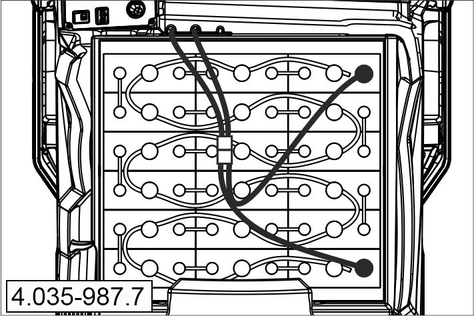
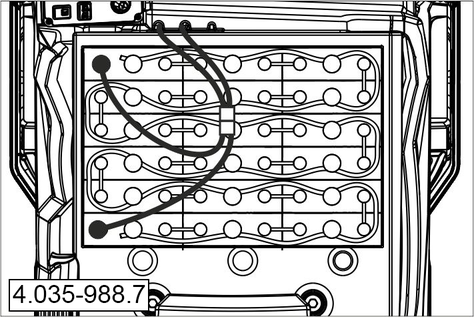
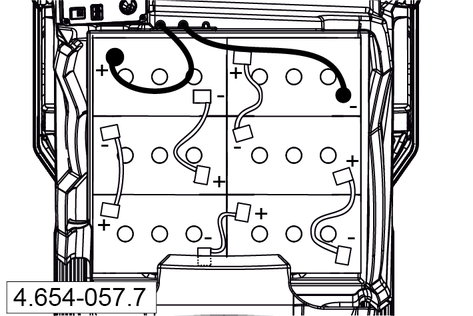
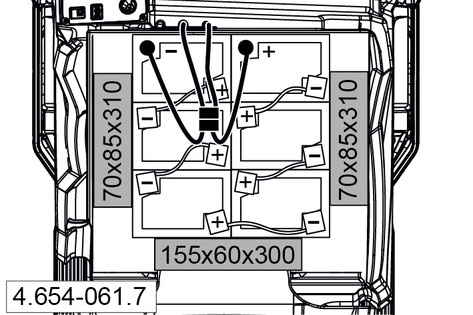
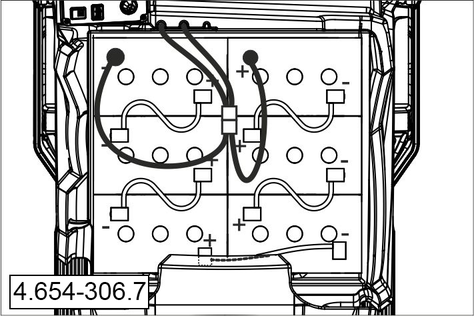
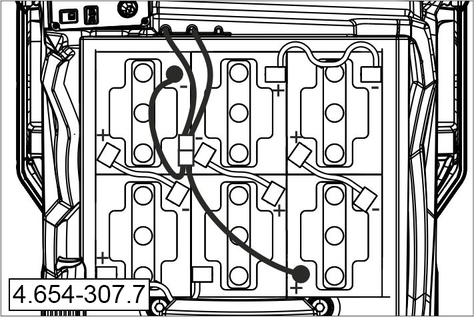
Connect the battery terminals using the connection cables provided.
Clamp the supplied connecting cable to the (+) and (‑) battery terminals that are still free.
Check for correct installation of the pole protection caps.
Connect the device-side battery connector to the battery-side battery connector.
Pivot the waste water tank forwards and close it.
Set the battery type (see chapter "Gray Intelligent Key").
Risk of damage
The battery can be damaged by deep discharge.
Charge the battery before initial startup of the device.
The device has deep discharge protection, i.e. the device can only be driven when the permitted minimum capacity level is reached. "Charging the battery" and "Charging the battery" appear in the display.
When using other batteries (e.g. from other manufacturers), the deep discharge protection for the respective battery must be reset by Kärcher Customer Service.
Inappropriate use of the charger
Flammable gases are generated when the battery is charged
Electric shock
Risk of explosion
Adhere to the mains voltage and fuse values specified on the device type plate.
Only use the charger in dry rooms with sufficient ventilation.
Only charge the batteries in a suitable room. The room must have a minimum volume depending on the battery type and an adequate air exchange rate with a minimum air flow (see "Recommended batteries").
Accumulation of dangerous gases under the tank during the charging process
Risk of explosion
Pivot the waste water tank upwards before charging low-maintenance batteries.
The average charging time is approx. 10-12 hours.
The recommended chargers (for the respective batteries) are electronically controlled and stop the charging process automatically.
The device cannot be used during the charging process.
Drive the device directly to the charger and do not drive on slopes.
Connect the mains cable to the IEC connector on the device.
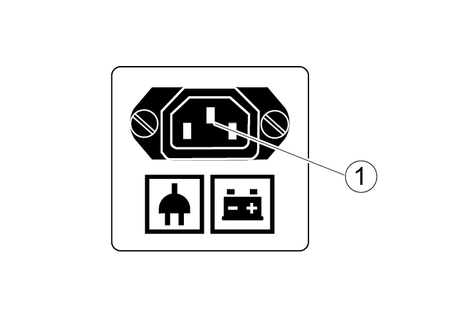
Plug the mains plug of the internal charger into the mains socket.
A battery symbol and the charging state of the batteries are shown in the display. The display lighting goes out.
All cleaning and driving functions are blocked during the charging process.
When the battery is fully charged, the display shows "Battery full!".
Unplug the charger mains plug from the mains socket after charging.
Wind the mains cable onto the cable holders.
Using an unsuitable charger
Risk of damage
Do not connect the charger to the device-side battery connector.
Use only a charger suitable for the type of battery installed.
Read the operating instructions of the charger manufacturer and observe the safety instructions in particular.
For devices with a overhead guard, always observe the notes in the "Overhead guard" chapter.
Empty the waste water tank.
Set the safety switch to "0".
Pivot the waste water tank to the rear.
Pull out the device-side battery connector.
Connect the battery-side battery connector to the charger.
Plug the mains plug of the charger into the socket.
Carry out the charging process in accordance with the operating instructions for the charger.
Connect the device-side battery connector to the battery-side battery connector.
Pivot the waste water tank forwards.
Refilling discharged batteries with water
Danger of acid burns from escaping acid, destruction of clothing
Wear safety goggles, protective clothing and protective gloves when handling the battery acid.
Observe the applicable regulations.
Immediately rinse off any splashed acid from the skin or clothing using copious amounts of water.
Using water with additives
Defective batteries, loss of warranty eligibility
Top up the batteries using only distilled or desalinated water (EN 50272-T3).
Do not use any foreign additives, so-called enhancing agents, because this will invalidate the warranty.
Add distilled water one hour before the charging process comes to an end. Observe the correct acid level according to the battery label.
All cells must produce gas at the end of the charging process.
Clean up any spilled water. To do this, proceed as described in the Care and maintenance chapter in the "Cleaning the batteries" section.
The controller does not yet recognize the battery type installed when initially charging the battery. The battery indicator then still works imprecisely.
A "V" to the right of the bar on the battery display indicates that initial charging has not yet been carried out.
Charge the batteries until the display shows the maximum charging state.
After initially charging the batteries, use the device until the deep discharge protection switches off the brush drive and suction.
Then fully and correctly charge the batteries.
The "V" to the right of the battery indicator disappears after initial charging.
If a battery type is selected in the battery menu, the procedure described above must be carried out again. This is also the case if the battery type that has already been set is selected again.
The charging state of the batteries is shown on the control panel display.
The length of the bar shows the charging state of the battery.
During the last 30 minutes, the remaining operating time is displayed in minutes.
Removing and installing the batteries
Unstable machine position
Ensure that the machine is positioned stably when removing and installing the batteries.
For devices with a overhead guard, always observe the notes in the "Overhead guard" chapter.
Set the safety switch to "0".
Drain the waste water.
Pivot the waste water tank to the rear.
Pull out the battery plug.
Disconnect the cable from the minus terminal at the battery.
Disconnect the remaining cables from the batteries.
Remove the batteries.
Dispose of the used batteries in accordance with statutory provisions.
Remove the packaging film.
Remove the strap.
4 bottom boards of the pallet are fastened with screws. Unscrew these boards.
Position the boards on the edge of the pallet and align them in front of the wheels on the device.

Secure the boards with the screws.
Slide the support bars provided in the packaging under the ramp.
Remove the wooden strips in front of the wheels.
With all device variants except "low wheel pressure", pull the brake lever on the front wheel and insert a coin between the lever and the brake.
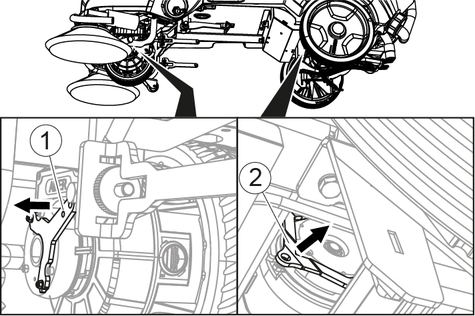
With the device variant "Adv" and "low wheel pressure" repeat the procedure on the rear axle.
Push the device slowly off the ramp.
Danger of accident
The device has no braking effect when the brakes are deactivated.
Remove the coins immediately after the device is pushed off the pallet.
Remove the coins between the lever and the housing.
The batteries must be installed and charged in order to drive off the pallet.
Insert the Intelligent Key into the control panel.
Set the safety switch to position "1"
Set the program switch to transport travel.
Set the travel direction switch to "Forward".
Depress the accelerator pedal.
Drive the device slowly off the pallet.
Set the safety switch to "0".
Installation of the cleaning head is described in the chapter "Maintenance tasks".
The cleaning head is already installed on some models.
The installation of the brushes is described in the chapter "Maintenance work".
Pivot both clamping levers upwards.
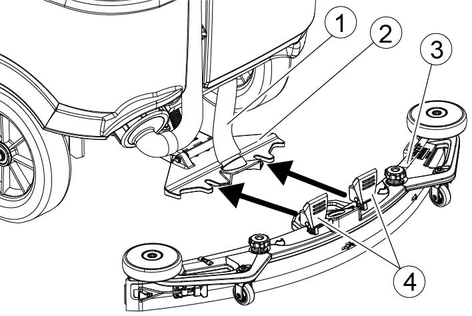
Insert the suction bar in the suction bar mount.
Pivot both clamping levers downwards.
Falling objects
Risk of injury
Do not used the device without an overhead guard to protect against falling objects in areas in which there is a possibility of operators being hit by falling objects.
Risks during operation
Risk of injury
In the event of danger, set the safety switch to "0".
Operate the seat adjustment lever and move the seat to the desired position.
Release the seat adjustment lever and latch the seat into position.
Sit in the driver's seat.
Insert the Intelligent Key.
Set the safety switch to "1".
Turn the program switch to the desired function.
If one of the displays below appears on the display, take your foot off the accelerator pedal, set the safety switch to "0" and carry out the necessary maintenance work.
Display | Activity |
|---|---|
Suction bar maintenance | Clean the suction bar. |
Brush head maintenance | Check the brushes for wear and clean them. |
Suction lip maintenance | Check the suction lips for wear and correct adjustment. |
Turbine sieve maintenance | Clean the turbine screen. |
Maintenance of the fresh water filter | Clean the fresh water filter. |
Press the Info button.
Reset the counter for the corresponding maintenance (see "Grey Intelligent Key / Reset maintenance counter").
If the counter is not reset, the maintenance display appears again each time the device is switched on.
The daytime running light is in operation when the device is switched on.
Set the program switch to transport travel.
Press the Info button.
Turn the Info button until "Switch menu" is displayed.
Press the Info button.
Turn the Info button until "Work light" is highlighted.
Press the Info button.
Danger of death due to defective parking brake!
The device may roll uncontrollably if the parking brake is not working properly.
Check the function of the parking brake on level ground before each use.
Switch the device on.
Set the travel direction switch to "Forward".
Set the program switch to transport travel.
Press the accelerator pedal lightly.
The brake must audibly unlock. The device must roll easily on level ground.
Release the accelerator pedal.
The brake must audibly lock.
If the parking brake does not lock, shut down the device, secure it against uncontrolled rolling and contact the customer service.
Lack of braking
Danger of accident
Before using the device, it is essential to check the function of the parking brake. Never use the device if the parking brake does not work.
No braking effect during operation
If the device no longer has any braking effect during operation, proceed as follows:
If the device does not come to a standstill on a ramp with a gradient of more than 2% when you release the accelerator pedal, for safety reasons you may only set the safety switch to position "0" if you have checked the correct mechanical function of the parking brake before starting up the device.
After reaching a standstill, put the device out of operation and call Customer Service.
Observe the maintenance instructions for brakes.
Careless driving
Increased risk of tipping over for devices with an overhead guard
Danger of tipping over
A risk of tipping over exists if the overhead guard collides with obstacles.
Only drive up and up gradients in the travel direction and across the travel direction up to maximum gradients of 10% (Adv 15%).
Do not turn up or down gradients.
Drive slowly in corners and on wet ground.
Only drive the device on stable ground.
Drive more carefully when using a device with an overhead guard.
Note the maximum headroom at the operating location. The height of the device is specified in the "Technical data" chapter.
Risk of injury
Move carefully so that your head does not hit the overhead guard when climbing on board the device.
The travel direction can be changed while driving. This means that very dull spots can be polished by moving back and forth several times.
Assume a seated position.
Insert the Intelligent Key.
Turn the safety switch to "1".
Set the program selector switch to "Transport travel".
Set the direction of travel using the drive direction button on the control panel.
Specify the travel speed by pressing the accelerator pedal.
Release the accelerator pedal.
The device stops.
The driving motor is switched off in the event of an overload. A fault message appears on the display. If the controller overheats, the affected power unit is switched off.
Allow the device to cool down for at least 15 minutes.
Set the program switch to “OFF”, wait briefly and set to the desired program.
Connect the water hose to the connection nozzle of the filling system (maximum water temperature 50 °C).
Open the water inlet.
Monitor the device, the automatic filling system interrupts the water supply when the fresh water tank is full.
Close the water inlet.
Remove the water hose.
Open the fresh water tank cap.
Fill with fresh water (max. 50 °C) to 15 mm below the upper edge of the tank.
Adding detergent to the detergent tank followed by water can lead to excessive foaming.
Fill the fresh water tank completely before initial startup in order to vent the water pipe system.
´Remove the fresh water tank cap.
Unsuitable detergents
Health risk, damage to the device
Use only recommended detergents. The operator carries all increased risks relating to operational safety and increased risk of accidents if using other detergents.
Use only detergents free of chlorine, solvents, salt and hydrofluoric acid.
Adhere to the safety instructions stated on the detergent packaging.
Do not use heavily foaming detergent.
Recommended detergents
Application | Detergent |
|---|---|
Maintenance cleaning of all water-resistant floors | RM 746 RM 756 RM 780 |
Maintenance cleaning of polished hard surfaces (e.g. granite) | RM 755 es |
Maintenance cleaning, intermediate cleaning and basic cleaning of industrial floors | RM 69 Industrial cleaner |
Maintenance cleaning and basic cleaning of fine stone tiles | RM 753 |
Maintenance cleaning of tiles in sanitary areas | RM 751 |
Coating removal on all alkaline-resistant floors (e.g. PVC) | RM 752 |
Coating removal on linoleum floors | RM 754 |
Only with DOSE variant:
Detergent is added to the fresh water on the way to the cleaning head by a dosing device.
Fill the detergent into the detergent canister.
A maximum of 3% detergent can be added with the dosing device. If the dosage is higher, the detergent must be added to the fresh water tank.
Danger of clogging
When adding detergent to the fresh water tank, the detergent can dry out and disrupt the function of the dosing device.
Rinse the device with clear water after adding the detergent to the fresh water tank: Select a cleaning program with water application, set the water quantity to the highest value, set the detergent dosage to 0.
The device has a fresh water level indicator on the display. Detergent dosing is also stopped when the fresh water tank is empty. The cleaning head continues to work without supply of liquid.
Fill the detergent into the fresh water tank.
Note: The lid for the filling hole of the fresh water tank can be used to measure the detergent. It has a measuring scale marked on the inner side.
The parameters for the various cleaning programs are preset in the device.
Individual parameters can be changed depending on the authorization of the yellow Intelligent Key.
The modified parameters only remain in effect until a different cleaning program is selected with the program switch.
A grey Intelligent Key must be used for making adjustments if parameters are to be changed permanently. This setting procedure is described in the section "Grey Intelligent Key".
Almost all displayed texts regarding parameter settings are self-explanatory. The only exception is the FACT parameter:
Fine Clean: Low brush speed for removing grey film from fine stone.
Whisper Clean: Medium brush speed for maintenance cleaning with reduced noise level.
Power Clean: High brush speed for polishing, crystallizing and sweeping.
Set the program switch to the desired cleaning program.
Turn the Info button until the desired parameter is displayed.
Press the Info button.
The adjusted value flashes.
Set the desired value by turning the Info button.
Confirm the changed setting by pressing the Info button or wait until the set value is automatically accepted after 10 seconds.
The suction bar only needs to be readjusted in special cases. The factory setting is suitable for most applications.
The inclination must be adjusted so that the suction lips of the suction bar make even contact with the floor over the entire length of the suction bar.
Park the device on a surface without a slope.
Turn the program switch to the "Vacuum" position.
Drive the device a small distance forwards.
Read the spirit level.

Unscrew the nut.
Adjust the screw so that the spirit level indicator is between the two lines.
Tighten the nut.
To check the new setting, move the device forward again a short distance. Repeat the adjustment process if necessary.
Turn the key-operated switch to "OFF".
The height adjustment affects the bending of the suction lips on contact with the floor.
Standard setting: 3 washers above, 3 washers below the suction bar.
Uneven floor: 5 washers above, 1 washer below the suction bar.
Very smooth floor: 1 washer above, 5 washers below the suction bar.
Unscrew the nuts.
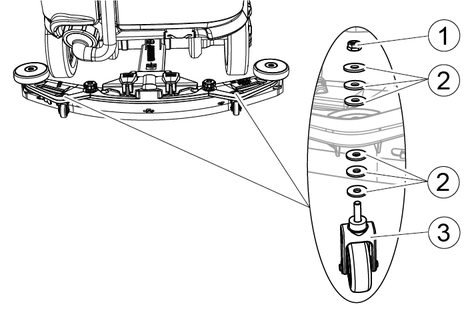
Place the desired number of washers between the suction bar and the spacer roller.
Fit the remaining unused washers above the spacer roller.
Screw on the nut and tighten.
Repeat the entire procedure at the second spacer roller.
Set both spacer rollers to the same height.
The squeegee blades only need to be adjusted on the D cleaning head.
Adjust the squeegee blades by turning the setting wheel so that the squeegee blade touches the ground.
Turn the adjustment wheel an additional 1 rotation down.
The hose with the spray nozzle is attached to the rear of the device. It is used for rinsing away dirt and manually cleaning the waste water tank.
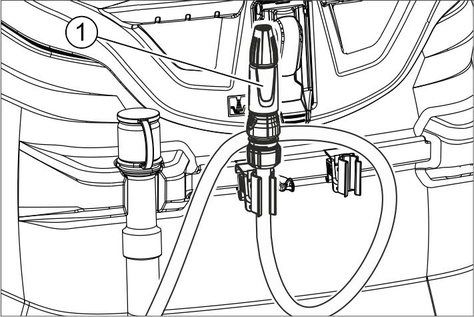
Close the spray nozzle by turning it.
Set the program selector switch to "Transport travel".
Press the Info button.
Turn the info button until "Tank rinsing" is shown on the display.
Press the Info button.
Turn the Info button until "ON" is displayed.
Press the Info button.
The water pump delivers fresh water through the spray nozzle.
Point the spray nozzle at the target and turn it to open it.
Sit on the seat.
Insert the Intelligent Key.
Set the safety switch to "1".
Set the travel direction switch to forward travel.
Set the program switch to the desired cleaning program.
Determine the speed with the accelerator pedal.
Determine the travel direction with the steering wheel.
Drive over the surface to be cleaned.
The side scrubbing deck makes working close to the edge easier.
The side scrubbing deck is not active in the polish and vacuum cleaning programmes.
Operate the side scrubbing deck switch.
The side scrubbing deck is activated.
To finish working with the side scrubbing deck, set the side scrubbing deck switch to "0" .
Set the programme switch to Drive.
Continue moving a short distance.
The residual water is vacuumed up.
Turn the key-operated switch to "OFF".
Remove the Intelligent Key.
Charge the battery if necessary.
Improper disposal of waste water
Environmental pollution
Observe the local waste water treatment regulations.
The suction turbine switches off and the display shows "" when the waste water tank is full.
Remove the waste water drain hose from the support and open the drain hose cover.
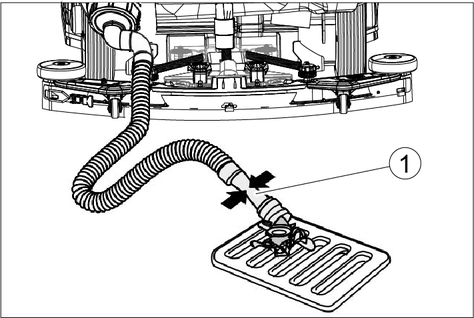
Squeeze the end of the hose and lower it over the disposal facility.
Adjust the strength of the waste water jet by squeezing the end of the hose.
Rinse the waste water tank with clear water.
Close the drain hose cover.
Press the waste water hose into the support on the device.
Remove the waste water drain hose from the support and open the drain hose cover.
Close the cover of the waste water tank.
Connect a water supply hose to the water connection of the waste water tank flushing system.
Open the water inlet and rinse the waste water tank for about 30 seconds.
Repeat the rinsing process 2 to 3 times if necessary.
Close the water inlet.
Disconnect the water supply hose from the device.
Close the waste water drain hose and press it into the support.
A coarse dirt container is only present on R cleaning heads.
Lift the coarse dirt container and pull it out.
Empty the coarse dirt container.
Reinstall the coarse dirt container.
Open the fresh water tank cap.
Drain the fresh water.
Clean the filter.
Fit the fresh water tank cap.
Turn the key-operated switch to "OFF".
Remove the Intelligent Key.
Secure the device against rolling away.
Charge the battery if necessary.
The grey Intelligent Key grants the supervisory staff extended authorizations and setting options.
Insert the Intelligent Key.
Select the desired function by turning the info button.
Set the program selector switch to "Transport travel".
Press the Info button.
The following settings can be made in the Transport travel menu:
Resetting the maintenance counter
Key management
Choosing the brush shape
After-running time
Setting the battery type
Standard setting
Setting the language
Switch menu
Factory setting
If maintenance work shown in the display has been carried out, the corresponding maintenance counter must then be reset.
Turn the Info button until "Maintenance counter" is displayed.
Press the Info button.
The counter readings are displayed.
Turn the info button until the counter to be cleared is highlighted.
Press the Info button.
Select "Yes" by turning the Info button.
Press the Info button.
The counter is cleared.
The service counter can only be reset by Customer Service staff.
The service counter shows the time until the next service due by Customer Service.
The authorizations are assigned for each yellow Intelligent Key used and the language of the display is set for this Intelligent Key in the "Key menu" menu item.
Insert the grey Intelligent Key.
Turn the info button until the "Key menu" menu item appears on the display.
Press the Info button.
Remove the grey Intelligent Key and insert the yellow or white Intelligent Key to be personalized.
Select the menu item to be changed by turning the info button.
Press the Info button.
Select the setting of the menu item by turning the info button.
Confirm the setting by pressing the menu item.
Select the next menu item to be changed by turning the info button.
After all settings have been made, call up the "Save?" menu by turning the info button.
Press the Info button.
The authorizations are saved.
The "Continue key menu" display appears.
Yes: Program another Intelligent Key
No: Exit the key menu
Press the Info button.
This function is required when changing the cleaning head.
Turn the info button until the "Brush head" menu item appears on the display.
Press the Info button.
Turn the info button until the desired brush shape is highlighted.
Press the Info button.
To change the cleaning head, move the lifting drive by turning the info button:
"Up": Lifting
"Down": Lowering
"OFF": Stopping
Turn the info button until the "OFF" menu item is displayed.
Press the Info button.
The menu is exited.
The controller performs a restart.
Turn the info button until the "After-running time" menu item appears on the display.
Press the Info button.
Turn the info button until the desired function is highlighted.
Press the Info button.
Turn the info button until the desired after-running time is displayed.
Press the Info button.
Turn the info button until the "Battery menu" menu item appears on the display.
Press the Info button.
Turn the info button until the desired battery type is highlighted.
Press the Info button.
Parameter changes made in the individual cleaning programs during operation are reset to the standard setting when the device is switched off.
Turn the info button until the "Standard setting" menu item appears on the display.
Press the Info button.
Turn the info button until the desired cleaning program is highlighted.
Press the Info button.
Turn the Info button until the desired parameter is highlighted.
Press the Info button.
The adjusted value flashes.
Set the desired value by turning the Info button.
Press the Info button.
Turn the info button until the "Language" menu item appears on the display.
Press the Info button.
Turn the info button until the desired language is highlighted.
Press the Info button.
The work light can be enabled or disabled in this menu.
Turn the Info button until "Switch menu" is displayed.
Press the Info button.
Turn the Info button until "Work light" is highlighted.
Press the Info button.
The factory settings for all cleaning parameters are restored.
Turn the info button until the "Factory setting" menu item is displayed.
Press the Info button.
Turn the Info button until "Yes" is highlighted.
Press the Info button.
All cleaning program parameters are retained until another setting is selected or the device is switched off.
Set the program switch to the desired cleaning program.
Press the Info button.
The first adjustable parameter is displayed.
Press the Info button
The adjusted value flashes.
Set the desired value by turning the Info button.
Confirm the changed setting by pressing the Info button or wait until the set value is automatically accepted after 10 seconds.
Select the next parameter by turning the Info button.
After changing all desired parameters, turn the Info button until the "Exit menu?" menu item is displayed.
Press the Info button.
The menu is exited.
Driving on slopes
Risk of injury
Observe the maximum permissible gradient when driving the device on slopes for loading and unloading purposes (see chapter "Technical data").
Drive slowly.
Failure to observe the weight
Risk of injury and damage
Be aware of the weight of the device during transportation.
With the D cleaning head installed, remove the disc brushes from the brush head.
When transporting in vehicles, secure the device against slipping and tipping over according to the applicable guidelines.
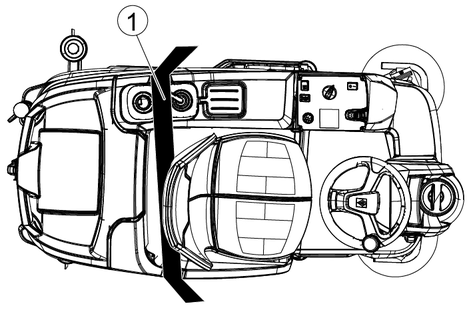
Failure to observe the weight
Risk of injury and damage
Be aware of the weight of the device during storage.
Frost
Destruction of the device through freezing water
Drain all water from the device.
Store the device in a frost-free location.
When choosing the parking space, take into account the total weight of the device in order not to impair its stability.
This device may only be stored indoors.
Fully charge the batteries before storing them for a long period.
Fully charge the batteries at least every month during storage.
Inadvertently starting up device
Risk of injury, electric shock
Turn the program switch to the “OFF” position.
Remove the Intelligent Key prior to all work on the device.
Pull out the charger mains plug.
Unplug the battery connector.
Risk of injury
The suction turbine continues to run after the device has been switched off.
Do not work on the device until the suction turbine is no longer running.
Drain and dispose of the waste water and fresh water.
Improper cleaning
Risk of damage.
Do not spray the device with water.
Do not use aggressive cleaning agents.
A detailed description of the individual maintenance work is provided in the chapter "Maintenance Work".
Drain the waste water.
Rinse the waste water tank.
Clean the coarse dirt filter.
Clean the turbine screen.
Only with R cleaning head: Remove the coarse dirt container and empty it.
Clean the exterior of the device using a damp cloth, wetted with a mild washing lye.
Check the suction lips, check for wear and replace if necessary.
Clean the squeegee blades, check for wear and replace if necessary.
Clean the brushes, check for wear and replace if necessary.
Charge the battery.
If the charging state of the battery is below 50%, charge the battery fully and without interruption.
If the charging state of the battery is above 50%, only recharge the battery if the entire operating duration will be required when next used.
When used regularly, charge the battery fully and without interruption at least once a week.
If the device is temporarily shut down (storage): Perform equalization charging of the battery.
Check battery poles for oxidation, brush off if necessary. Make sure the connection cables are firmly in place.
Clean the seals between the waste water tank and the cover, check for leaks and replace if necessary.
Check the acid density of the cells if the batteries are not maintenance-free.
Only with R cleaning head: Clean the brush tunnel.
Only with R cleaning head: Pull the water distribution strip off the cleaning head and clean the water channel.
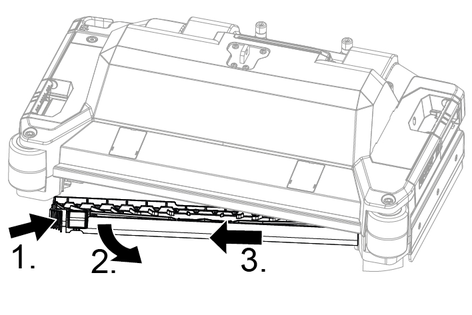
For longer periods of disuse, shut down the device when the batteries are fully charged. Fully charge the battery at least once a month.
Have the prescribed inspection performed by Customer Service.
You can agree on regular safety inspections or close a maintenance contract with your dealer. Please seek advice on this.
Open the waste water tank cover.
Press the locking hooks together.
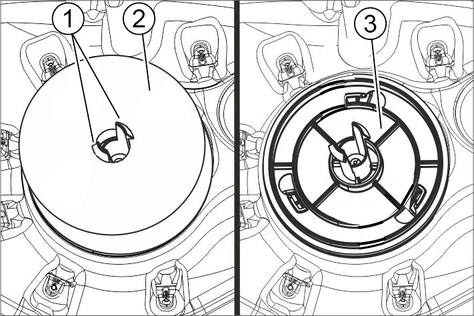
Pull off the float.
Turn the turbine screen anticlockwise.
Remove the turbine screen.
Clean the turbine screen under running water.
Reinstall the turbine screen.
Attach the float.
The suction lips must be turned over or replaced when worn out.
The suction lips can be turned 3 times until all 4 edges are worn.
Remove the suction bar.
Unscrew the star handles.

Pull out the inner part of the suction bar.
Open the tension lock.
Remove the strap.
Release the suction lips from the inner part.
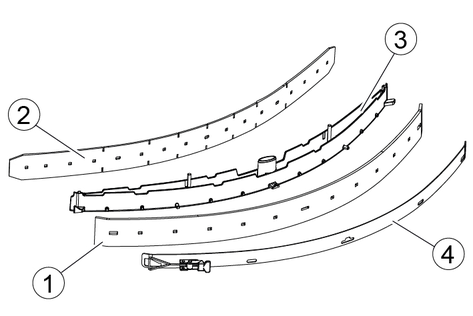
Press the turned or new suction lips onto the knobs of the inner part of the suction bar.
Attach the strap.
Push the inner part of the suction bar into the upper part.
Screw in and tighten the star handles.
Open the waste water tank cover.
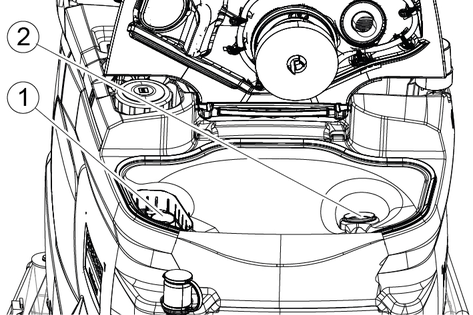
Pull the coarse dirt filter upwards and off.
Rinse off the coarse dirt filter under running water.
Reinsert the coarse dirt filter into the waste water tank.
Lift the holder of the cleaning head (see chapter "Gray Intelligent Key/... / Selecting the brush shape").
Push the cleaning head under the device so that the hose points to the rear.
Push the cleaning head halfway under the device.
Press the latching lug to the left and remove the cover from the cleaning head.
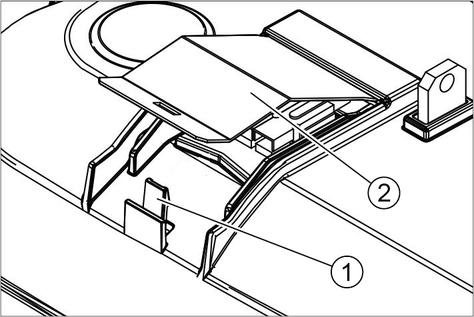
Connect the power supply cable of the cleaning head to the cable of the device (the same colours must line up).
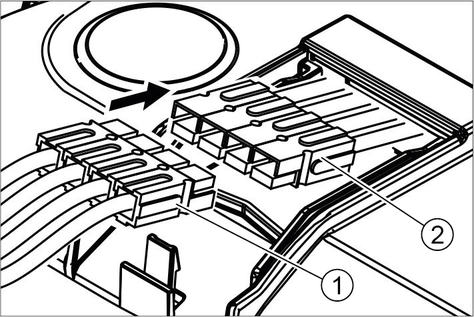
Fit the cover and latch into place.
Push the cleaning head centrally under the device.
Connect the hose coupling on the cleaning head to the hose on the device.
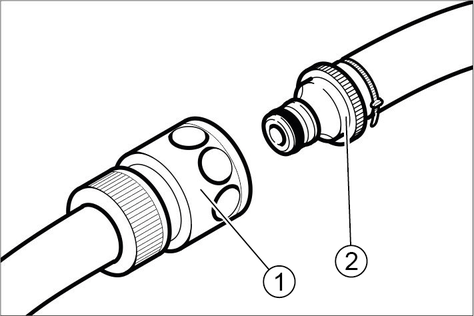
Insert the tab in the middle of the cleaning head into the fork in the lever.
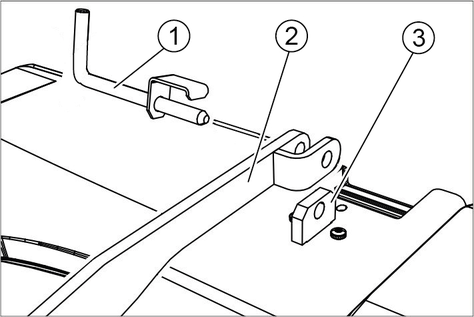
Align the holder of the cleaning head so that the holes in the lever and the cleaning head line up.
Insert the retaining pin through the holes and pivot the locking plate down.
Push the straight pin into the hole in the pull rod.
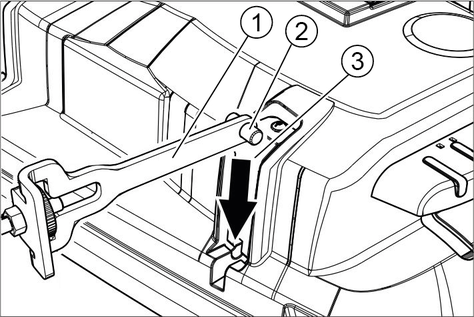
Push the pull rod in the guide channel on the cleaning head all the way to the bottom.
Insert the locking plate in the guide channel and click into place.
Repeat the procedure with the pull rod on the opposite side.
Insert the grey Intelligent Key.
Set the "Disc" brush type.
Press in the locking plate and pivot the pull rod upwards.
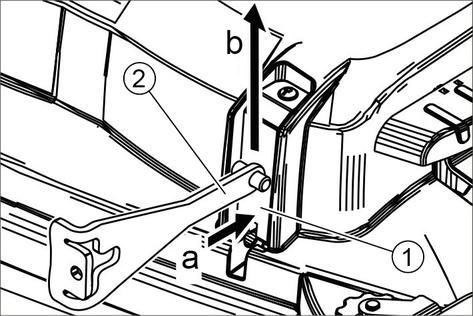
Further removal is performed in the reverse order to installation.
Remove both covers.
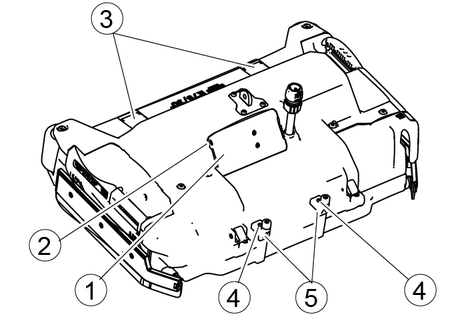
Unscrew the screws for the holders.
Remove both holders.
Unscrew the screw on the cover.
Attach both tie rods to the eye bolts.
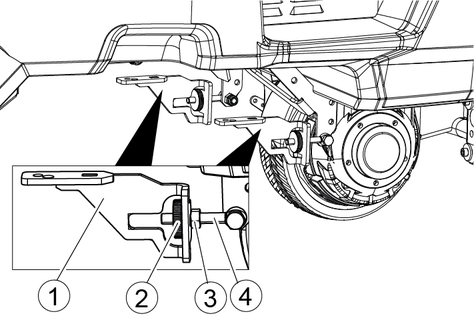
Push the cleaning head centrally under the device.
Fasten both tie rods to the holders (tightening torque: 25 Nm).
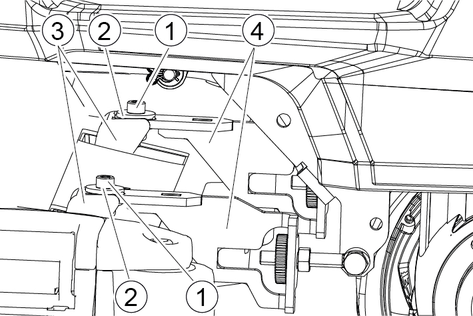
Insert the tab in the middle of the cleaning head into the fork in the lever.

Align the holder of the cleaning head so that the holes in the lever and the cleaning head line up.
Insert the bolt through the fork and tab.
Thread a washer onto the bolt.
Secure the bolt with a spring pin.
Connect the hose coupling on the cleaning head to the hose on the device.

Open the cover.
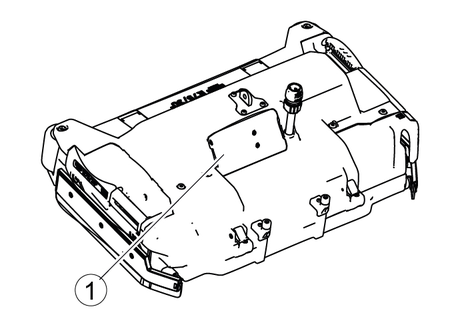
Connect the power supply cable of the cleaning head to the cable of the device (the same colours must line up).
Fit the cover and secure it with the screw.
Place a spirit level on the side of the cleaning head parallel to the travel direction.
Align the cleaning head horizontally by adjusting the knurled screw and the nut on the eyebolt.
Repeat the adjustment on the other side of the device.
Insert the grey Intelligent Key.
Set the "Brush" brush type.
Replace the roller brushes when the bristle length has reached 10 mm.
Raise the cleaning head.
Pull out the brush replacement handle.
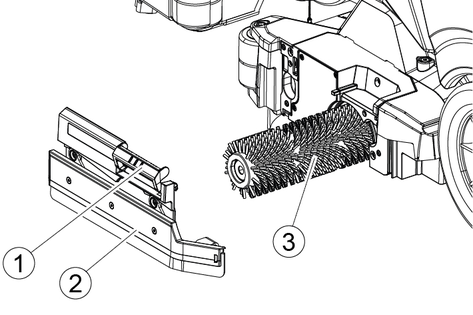
Remove the bearing cover including the squeegee blade.
Pull out the roller brush.
Fit the new roller brush and centre it on the driver.
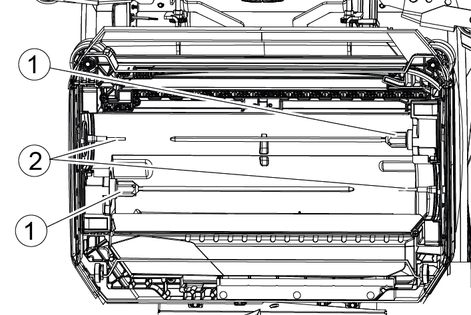
Install the bearing cover with the squeegee blade.
Make sure the roller brush sits on the mounting mandrel and not underneath.
Pivot the brush replacement handle upwards and latch it into place.
Repeat the entire procedure at the other side.
Raise the cleaning head.
Press the brush replacement pedal down, beyond the zone of resistance.
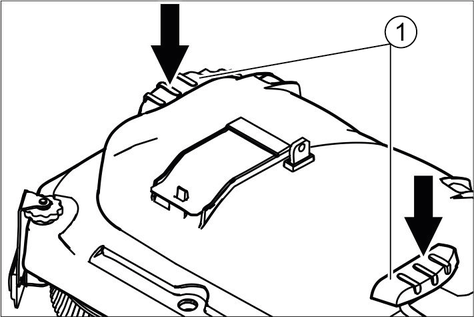
Pull the 1st disc brush sideways and out from underneath the cleaning head.
Hold the new disc brush under the cleaning head, then press upwards and latch it into position.
Repeat the procedure for the 2nd disc brush.
Press the brush replacement lever downwards.
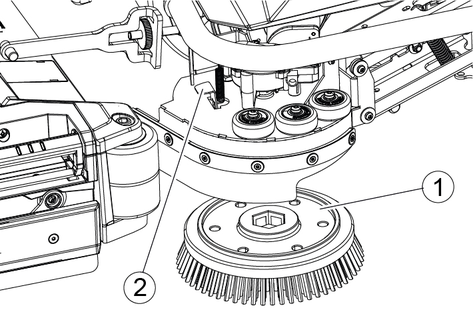
The brush falls out of the support.
Hold the new brush under the side scrubbing deck, then press upwards and latch it into position
Unscrew the 3 screws.
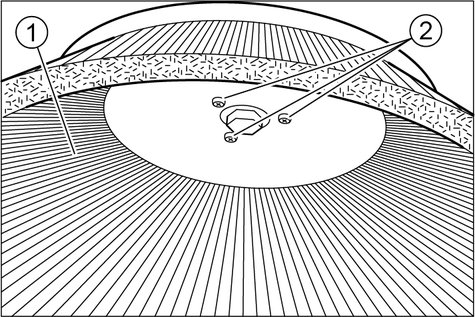
Remove the side brush.
Slide on the new side brush.
Screw in and tighten the 3 screws.
Drain the fresh water (see chapter "Draining fresh water").
Unscrew the fresh water tank cap.

Pull out the fresh water filter and rinse with clean water.
Insert the fresh water filter.
Fit the fresh water tank lock.
Note: Take care to ensure that the hose connection in the fresh water tank cap is positioned at the lowest point in the tank after screwing the cap in place.
The device can start unintentionally
People working on the device can be injured.
Remove the Intelligent Key prior to all work on the device.
Before carrying out any work, pull the mains plug of the internal charger out of the socket.
Disconnect the battery connector before performing any work.
Drain the waste water.
Drain the remaining fresh water.
If the malfunction cannot be remedied with the following instructions, contact Customer Service.
If faults are shown on the display, proceed as follows:
Fault display as a numerical code
In the event of a fault display with a numerical code, first reset the fault (the device):
Set the programme switch to "OFF".
Wait until the numeric code has gone out on the display.
Set the program switch to the previous program.
Carry out the appropriate remedial measures in the order given only if the error occurs again. The key-operated switch must be set to "0" and the emergency stop button must be pressed.
If the error cannot be rectified, call Customer Service and state the error message.
Fault display as text
Follow the instructions on the display.
Acknowledge the fault by pressing the info button.
Error messages that are not listed in the following table indicate errors that cannot be rectified by the operator. In this case, please call Customer Service.
The device cannot be started
Remedy:
Sit in the driver's seat.
Take your foot off the accelerator before switching on the safety switch.
Turn the safety switch to "1".
Check the battery and charge if necessary.
Set the programme switch to "OFF".
Wait 10 seconds.
Set the program switch to the desired program.
If possible, only drive the device on level ground.
Check the parking brake if necessary.
If the fault still occurs, call Customer Service.
The water volume is insufficient
Remedy:
Check the fresh water filling level, if necessary fill the tank completely so that the air is pressed out.
Remove and clean the fresh water filter.
Insert the filter and screw on the cap.
Only with R cleaning head: Pull off the water distribution strip on the cleaning head.
Only with R cleaning head: Clean the water channel.
Check the hoses for clogging and clean if necessary.
The suction performance is too low
Remedy:
Clean the seals between the waste water tank and the cover, check for leaks and replace if necessary.
Check the turbine screen for soiling and clean if necessary.
Clean the suction lips at the suction bar, turn over or replace if necessary.
Close the lid on the waste water drain hose.
Close the cover of the waste water tank rinsing system.
Check the suction hose for clogging and clean if necessary.
Check the suction hose for leaks and replace if necessary.
Check the adjustment of the suction bar.
The cleaning results are unsatisfactory
Remedy:
Set the appropriate cleaning program for the cleaning task.
Use suitable brushes for the cleaning task.
Use a suitable detergent for the cleaning task.
Reduce the driving speed.
Adjust the contact pressure.
Adjust the squeegee blades.
Check the brushes for wear and replace if necessary.
Check the water output.
The brushes do not rotate
Remedy:
Reduce the contact pressure.
Check if the brushes are blocked by a foreign body and remove the foreign body if necessary.
If the motor is overloaded, let the motor cool down.
Set the programme switch to "OFF".
Wait 10 seconds.
Set the program switch to the desired program.
Check that the plug of the device is plugged into the cleaning head.
The device does not brake
Remedy:
Remove the brake disabling measures (see "Assembly/Unpacking/Pushing the device off the pallet").
The waste water drain hose is clogged
Remedy:
Open the dosing unit cover at the drain hose.
Pull the suction hose off the suction bar and close it by hand.
Set the programme switch to "Vacuum".
The blockage is sucked out of the drain hose into the waste water tank.
The "Dose" detergent dosing unit does not work
Remedy:
"Dose" version only: Call Customer Service.
The warranty conditions issued by our sales company responsible apply in all countries. We shall remedy possible malfunctions on your device within the warranty period free of cost, provided that a material or manufacturing defect is the cause. In a warranty case, please contact your dealer (with the purchase receipt) or the next authorised customer service site.
You can find more detailed information at: www.kaercher.com/dealersearch
General | |
Travel speed, max. (Adv) | 6 (10) km/h |
Theoretical surface performance (Adv) | 4500 (7500) m2/h |
Theoretical surface performance with side scrubbing deck | - m2/h |
Practical surface performance | 3200 (5300) m2/h |
Volume of fresh water/waste water tank B 150 (B 200) | 150 (200) l |
Coarse dirt container capacity | 7 l |
Volume of detergent tank ("Dose" option) | 5 l |
Detergent dosing | 0...3 % |
Water dosage | 0...7 l/min |
Load per unit area (with driver and full fresh water tank) | |
Front wheel surface pressure B 150 (B 200) | 0,94 (0,98) N/mm2 |
Rear wheel surface pressure B 150 (B 200) | 0,51 (0,67) N/mm2 |
Load per unit area (weight/parking area) (Adv) B 150 / B 200 | 599 (612) / 567 /--) kg/m2 |
Front wheel surface pressure B 150 low wheel pressure | 0,172 N/mm2 |
Rear wheel surface pressure B 150 low wheel pressure left/right | 0,221 / 0,228 N/mm2 |
Dimensions | |
Length B 150 (B 200) | 1690 (1940) mm |
Width without suction bar B 150 (B 200) | 810 (850) mm |
Height | 1390 mm |
Height with overhead guard (option) | 2060 mm |
Working width | 750 mm |
Working width with side scrubbing deck | - mm |
Working width with side brushes | 1080 mm |
Packaging dimensions lxwxh B 150 (B 200) | 1870x1120x1700 (2040x1120x1800) mm |
Tyres | |
Front wheel, width (low wheel pressure) | 90 (235) mm |
Front wheel, diameter (low wheel pressure) | 265 (290) mm |
Rear wheel, width (low wheel pressure) | 75 (125) mm |
Rear wheel, diameter (low wheel pressure) | 350 (350) mm |
Weight | |
Permissible overall weight B 150 (B 200) | 957 (994) kg |
Net weight (transport weight) B 150 (B 200) | 727 (699) kg |
Brush contact force, max. | 765 (78) N (kg) |
Brush contact pressure, max. | 27300 (280) N / m2 (g / cm2) |
Device performance data | |
Nominal voltage | 36 V |
Battery capacity | 170 / 180 / 240 / 285 Ah (5 h) |
Mean power input (Adv) | 2300 (3200) W |
Average power consumption with side scrubbing deck (Adv) | 2400 (3300) W |
Driving motor power (Adv) | 600 (1400) W |
Suction turbine power | 750 W |
Brush drive power | 2 x 600 W |
Degree of protection | IPX3 |
Vacuuming | |
Suction performance, air quantity | 27,3 l/s |
Vacuum (max.) | 21,1 (211) kPa (mbar) |
Cleaning brushes | |
Brush diameter | 105 mm |
Brush length | 700 mm |
Brush speed | 1200 1/min |
Side scrubbing deck brush diameter | - mm |
Side scrubbing deck brush speed | - 1/min |
Internal charger | |
Nominal voltage | 230 V |
Frequency | 50-60 Hz |
Current consumption | 8 A |
Ambient conditions | |
Permissible temperature range | 5...40 °C |
Water temperature max. | 50 °C |
Filling system water pressure (Option) | 1 (10) MPa (bar) |
Waste water tank flushing system water pressure (option) | 1 (10) MPa (bar) |
Relative humidity | 20...90 % |
Incline | |
Max. working area slope (Adv) | 10 (15) % |
Determined values in acc. with EN 60335-2-72 | |
Hand-arm vibration value | <2,5 m/s2 |
Seat vibration value | <2,5 m/s2 |
Uncertainty K | 0,1 dB(A) |
Sound level LpA normal operation | 67 dB(A) |
Uncertainty KpA | 2 dB(A) |
Sound power level LWA + Uncertainty KWA normal operation | 85 dB(A) |
Side scrubbing deck | |
Power | - W |
Brush contact force, max. | - N (kg) |
Brush contact pressure, max. | - N / m2 (g / cm2) |
General | |
Travel speed, max. (Adv) | 6 (10) km/h |
Theoretical surface performance (Adv) | 4500 (7500) m2/h |
Theoretical surface performance with side scrubbing deck | - m2/h |
Practical surface performance | 3200 (5300) m2/h |
Volume of fresh water/waste water tank B 150 (B 200) | 150 (200) l |
Coarse dirt container capacity | - l |
Volume of detergent tank ("Dose" option) | 5 l |
Detergent dosing | 0...3 % |
Water dosage | 0...7 l/min |
Load per unit area (with driver and full fresh water tank) | |
Front wheel surface pressure B 150 (B 200) | 0,94 (0,98) N/mm2 |
Rear wheel surface pressure B 150 (B 200) | 0,51 (0,67) N/mm2 |
Load per unit area (weight/parking area) (Adv) B 150 / B 200 | 599 (612) / 567 /--) kg/m2 |
Front wheel surface pressure B 150 low wheel pressure | 0,172 N/mm2 |
Rear wheel surface pressure B 150 low wheel pressure left/right | 0,221 / 0,228 N/mm2 |
Dimensions | |
Length B 150 (B 200) | 1690 (1940) mm |
Width without suction bar B 150 (B 200) | 810 (850) mm |
Height | 1390 mm |
Height with overhead guard (option) | 2060 mm |
Working width | 750 mm |
Working width with side scrubbing deck | - mm |
Working width with side brushes | 1080 mm |
Packaging dimensions lxwxh B 150 (B 200) | 1870x1120x1700 (2040x1120x1800) mm |
Tyres | |
Front wheel, width (low wheel pressure) | 90 (235) mm |
Front wheel, diameter (low wheel pressure) | 265 (290) mm |
Rear wheel, width (low wheel pressure) | 75 (125) mm |
Rear wheel, diameter (low wheel pressure) | 350 (350) mm |
Weight | |
Permissible overall weight B 150 (B 200) | 957 (994) kg |
Net weight (transport weight) B 150 (B 200) | 727 (699) kg |
Brush contact force, max. | 641 (65) N (kg) |
Brush contact pressure, max. | 3700 (40) N / m2 (g / cm2) |
Device performance data | |
Nominal voltage | 36 V |
Battery capacity | 170 / 180 / 240 / 285 Ah (5 h) |
Mean power input (Adv) | 2200 (3100) W |
Average power consumption with side scrubbing deck (Adv) | 2300 (3200) W |
Driving motor power (Adv) | 600 (1400) W |
Suction turbine power | 750 W |
Brush drive power | 2 x 600 W |
Degree of protection | IPX3 |
Vacuuming | |
Suction performance, air quantity | 27,3 l/s |
Vacuum (max.) | 21,1 (211) kPa (mbar) |
Cleaning brushes | |
Brush diameter | 410 mm |
Brush length | - mm |
Brush speed | 180 1/min |
Side scrubbing deck brush diameter | - mm |
Side scrubbing deck brush speed | - 1/min |
Internal charger | |
Nominal voltage | 230 V |
Frequency | 50-60 Hz |
Current consumption | 8 A |
Ambient conditions | |
Permissible temperature range | 5...40 °C |
Water temperature max. | 50 °C |
Filling system water pressure (Option) | 1 (10) MPa (bar) |
Waste water tank flushing system water pressure (option) | 1 (10) MPa (bar) |
Relative humidity | 20...90 % |
Incline | |
Max. working area slope (Adv) | 10 (15) % |
Determined values in acc. with EN 60335-2-72 | |
Hand-arm vibration value | <2,5 m/s2 |
Seat vibration value | <2,5 m/s2 |
Uncertainty K | 0,1 dB(A) |
Sound level LpA normal operation | 67 dB(A) |
Uncertainty KpA | 2 dB(A) |
Sound power level LWA + Uncertainty KWA normal operation | 85 dB(A) |
Side scrubbing deck | |
Power | - W |
Brush contact force, max. | - N (kg) |
Brush contact pressure, max. | - N / m2 (g / cm2) |
General | |
Travel speed, max. (Adv) | 6 (10) km/h |
Theoretical surface performance (Adv) | 5100 (8500) m2/h |
Theoretical surface performance with side scrubbing deck | 5700 (9500) m2/h |
Practical surface performance | 3600 (6000) m2/h |
Volume of fresh water/waste water tank B 150 (B 200) | 150 (200) l |
Coarse dirt container capacity | 9 l |
Volume of detergent tank ("Dose" option) | 5 l |
Detergent dosing | 0...3 % |
Water dosage | 0...7 l/min |
Load per unit area (with driver and full fresh water tank) | |
Front wheel surface pressure B 150 (B 200) | 0,94 (0,98) N/mm2 |
Rear wheel surface pressure B 150 (B 200) | 0,51 (0,67) N/mm2 |
Load per unit area (weight/parking area) (Adv) B 150 / B 200 | 599 (612) / 567 /--) kg/m2 |
Front wheel surface pressure B 150 low wheel pressure | 0,172 N/mm2 |
Rear wheel surface pressure B 150 low wheel pressure left/right | 0,221 / 0,228 N/mm2 |
Dimensions | |
Length B 150 (B 200) | 1690 (1940) mm |
Width without suction bar B 150 (B 200) | 910 (910) mm |
Height | 1390 mm |
Height with overhead guard (option) | 2060 mm |
Working width | 850 mm |
Working width with side scrubbing deck | 950 mm |
Working width with side brushes | 1080 mm |
Packaging dimensions lxwxh B 150 (B 200) | 1870x1120x1700 (2040x1120x1800) mm |
Tyres | |
Front wheel, width (low wheel pressure) | 90 (235) mm |
Front wheel, diameter (low wheel pressure) | 265 (290) mm |
Rear wheel, width (low wheel pressure) | 75 (125) mm |
Rear wheel, diameter (low wheel pressure) | 350 (350) mm |
Weight | |
Permissible overall weight B 150 (B 200) | 957 (994) kg |
Net weight (transport weight) B 150 (B 200) | 727 (699) kg |
Brush contact force, max. | 844 (86) N (kg) |
Brush contact pressure, max. | 26400 (270) N / m2 (g / cm2) |
Device performance data | |
Nominal voltage | 36 V |
Battery capacity | 170 / 180 / 240 / 285 Ah (5 h) |
Mean power input (Adv) | 2600 (3500) W |
Average power consumption with side scrubbing deck (Adv) | 2700 (3600) W |
Driving motor power (Adv) | 600 (1400) W |
Suction turbine power | 750 W |
Brush drive power | 2 x 750 W |
Degree of protection | IPX3 |
Vacuuming | |
Suction performance, air quantity | 27,3 l/s |
Vacuum (max.) | 21,1 (211) kPa (mbar) |
Cleaning brushes | |
Brush diameter | 105 mm |
Brush length | 800 mm |
Brush speed | 1200 1/min |
Side scrubbing deck brush diameter | 220 mm |
Side scrubbing deck brush speed | 210 1/min |
Internal charger | |
Nominal voltage | 230 V |
Frequency | 50-60 Hz |
Current consumption | 8 A |
Ambient conditions | |
Permissible temperature range | 5...40 °C |
Water temperature max. | 50 °C |
Filling system water pressure (Option) | 1 (10) MPa (bar) |
Waste water tank flushing system water pressure (option) | 1 (10) MPa (bar) |
Relative humidity | 20...90 % |
Incline | |
Max. working area slope (Adv) | 10 (15) % |
Determined values in acc. with EN 60335-2-72 | |
Hand-arm vibration value | <2,5 m/s2 |
Seat vibration value | <2,5 m/s2 |
Uncertainty K | 0,1 dB(A) |
Sound level LpA normal operation | 67 dB(A) |
Uncertainty KpA | 2 dB(A) |
Sound power level LWA + Uncertainty KWA normal operation | 85 dB(A) |
Side scrubbing deck | |
Power | 140 W |
Brush contact force, max. | 88 (9) N (kg) |
Brush contact pressure, max. | 2943 (30) N / m2 (g / cm2) |
General | |
Travel speed, max. (Adv) | 6 (10) km/h |
Theoretical surface performance (Adv) | 5400 (9000) m2/h |
Theoretical surface performance with side scrubbing deck | 6000 (10000) m2/h |
Practical surface performance | 3800 (6300) m2/h |
Volume of fresh water/waste water tank B 150 (B 200) | 150 (200) l |
Coarse dirt container capacity | - l |
Volume of detergent tank ("Dose" option) | 5 l |
Detergent dosing | 0...3 % |
Water dosage | 0...7 l/min |
Load per unit area (with driver and full fresh water tank) | |
Front wheel surface pressure B 150 (B 200) | 0,94 (0,98) N/mm2 |
Rear wheel surface pressure B 150 (B 200) | 0,51 (0,67) N/mm2 |
Load per unit area (weight/parking area) (Adv) B 150 / B 200 | 599 (612) / 567 /--) kg/m2 |
Front wheel surface pressure B 150 low wheel pressure | 0,172 N/mm2 |
Rear wheel surface pressure B 150 low wheel pressure left/right | 0,221 / 0,228 N/mm2 |
Dimensions | |
Length B 150 (B 200) | 1690 (1940) mm |
Width without suction bar B 150 (B 200) | 980 (980) mm |
Height | 1390 mm |
Height with overhead guard (option) | 2060 mm |
Working width | 900 mm |
Working width with side scrubbing deck | 1000 mm |
Working width with side brushes | 1080 mm |
Packaging dimensions lxwxh B 150 (B 200) | 1870x1120x1700 (2040x1120x1800) mm |
Tyres | |
Front wheel, width (low wheel pressure) | 90 (235) mm |
Front wheel, diameter (low wheel pressure) | 265 (290) mm |
Rear wheel, width (low wheel pressure) | 75 (125) mm |
Rear wheel, diameter (low wheel pressure) | 350 (350) mm |
Weight | |
Permissible overall weight B 150 (B 200) | 957 (994) kg |
Net weight (transport weight) B 150 (B 200) | 727 (699) kg |
Brush contact force, max. | 778 (79) N (kg) |
Brush contact pressure, max. | 2800 (30) N / m2 (g / cm2) |
Device performance data | |
Nominal voltage | 36 V |
Battery capacity | 170 / 180 / 240 / 285 Ah (5 h) |
Mean power input (Adv) | 2400 (3300) W |
Average power consumption with side scrubbing deck (Adv) | 2500 (3400) W |
Driving motor power (Adv) | 600 (1400) W |
Suction turbine power | 750 W |
Brush drive power | 2 x 600 W |
Degree of protection | IPX3 |
Vacuuming | |
Suction performance, air quantity | 27,3 l/s |
Vacuum (max.) | 21,1 (211) kPa (mbar) |
Cleaning brushes | |
Brush diameter | 450 mm |
Brush length | - mm |
Brush speed | 180 1/min |
Side scrubbing deck brush diameter | 220 mm |
Side scrubbing deck brush speed | 210 1/min |
Internal charger | |
Nominal voltage | 230 V |
Frequency | 50-60 Hz |
Current consumption | 8 A |
Ambient conditions | |
Permissible temperature range | 5...40 °C |
Water temperature max. | 50 °C |
Filling system water pressure (Option) | 1 (10) MPa (bar) |
Waste water tank flushing system water pressure (option) | 1 (10) MPa (bar) |
Relative humidity | 20...90 % |
Incline | |
Max. working area slope (Adv) | 10 (15) % |
Determined values in acc. with EN 60335-2-72 | |
Hand-arm vibration value | <2,5 m/s2 |
Seat vibration value | <2,5 m/s2 |
Uncertainty K | 0,1 dB(A) |
Sound level LpA normal operation | 67 dB(A) |
Uncertainty KpA | 2 dB(A) |
Sound power level LWA + Uncertainty KWA normal operation | 85 dB(A) |
Side scrubbing deck | |
Power | 140 W |
Brush contact force, max. | 88 (9) N (kg) |
Brush contact pressure, max. | 2943 (30) N / m2 (g / cm2) |
General | |
Travel speed, max. (Adv) | 6 (10) km/h |
Theoretical surface performance (Adv) | 6600 m2/h |
Theoretical surface performance with side scrubbing deck | - m2/h |
Practical surface performance | 4600 m2/h |
Volume of fresh water/waste water tank B 150 (B 200) | 150 (200) l |
Coarse dirt container capacity | - l |
Volume of detergent tank ("Dose" option) | 5 l |
Detergent dosing | 0...3 % |
Water dosage | 0...7 l/min |
Load per unit area (with driver and full fresh water tank) | |
Front wheel surface pressure B 150 (B 200) | 0,94 (0,98) N/mm2 |
Rear wheel surface pressure B 150 (B 200) | 0,51 (0,67) N/mm2 |
Load per unit area (weight/parking area) (Adv) B 150 / B 200 | 599 (612) / 567 /--) kg/m2 |
Front wheel surface pressure B 150 low wheel pressure | 0,172 N/mm2 |
Rear wheel surface pressure B 150 low wheel pressure left/right | 0,221 / 0,228 N/mm2 |
Dimensions | |
Length B 150 (B 200) | 1690 (1940) mm |
Width without suction bar B 150 (B 200) | 1110 mm |
Height | 1390 mm |
Height with overhead guard (option) | 2060 mm |
Working width | 1100 mm |
Working width with side scrubbing deck | - mm |
Working width with side brushes | 1080 mm |
Packaging dimensions lxwxh B 150 (B 200) | 1870x1120x1700 (2040x1120x1800) mm |
Tyres | |
Front wheel, width (low wheel pressure) | 90 (235) mm |
Front wheel, diameter (low wheel pressure) | 265 (290) mm |
Rear wheel, width (low wheel pressure) | 75 (125) mm |
Rear wheel, diameter (low wheel pressure) | 350 (350) mm |
Weight | |
Permissible overall weight B 150 (B 200) | 957 (994) kg |
Net weight (transport weight) B 150 (B 200) | 727 (699) kg |
Brush contact force, max. | 925 (94) N (kg) |
Brush contact pressure, max. | 2400 (25) N / m2 (g / cm2) |
Device performance data | |
Nominal voltage | 36 V |
Battery capacity | 170 / 180 / 240 / 285 Ah (5 h) |
Mean power input (Adv) | 2500 W |
Average power consumption with side scrubbing deck (Adv) | 2600 W |
Driving motor power (Adv) | 600 W |
Suction turbine power | 750 W |
Brush drive power | 2 x 600 W |
Degree of protection | IPX3 |
Vacuuming | |
Suction performance, air quantity | 27,3 l/s |
Vacuum (max.) | 21,1 (211) kPa (mbar) |
Cleaning brushes | |
Brush diameter | 550 mm |
Brush length | - mm |
Brush speed | 180 1/min |
Side scrubbing deck brush diameter | - mm |
Side scrubbing deck brush speed | - 1/min |
Internal charger | |
Nominal voltage | 230 V |
Frequency | 50-60 Hz |
Current consumption | 8 A |
Ambient conditions | |
Permissible temperature range | 5...40 °C |
Water temperature max. | 50 °C |
Filling system water pressure (Option) | 1 (10) MPa (bar) |
Waste water tank flushing system water pressure (option) | 1 (10) MPa (bar) |
Relative humidity | 20...90 % |
Incline | |
Max. working area slope (Adv) | 10 (15) % |
Determined values in acc. with EN 60335-2-72 | |
Hand-arm vibration value | <2,5 m/s2 |
Seat vibration value | <2,5 m/s2 |
Uncertainty K | 0,1 dB(A) |
Sound level LpA normal operation | 67 dB(A) |
Uncertainty KpA | 2 dB(A) |
Sound power level LWA + Uncertainty KWA normal operation | 85 dB(A) |
Side scrubbing deck | |
Power | - W |
Brush contact force, max. | - N (kg) |
Brush contact pressure, max. | - N / m2 (g / cm2) |
EU Declaration of Conformity |
We hereby declare that the machine described below complies with the relevant basic safety and health requirements in the EU Directives, both in its basic design and construction as well as in the version placed in circulation by us. This declaration is invalidated by any changes made to the machine that are not approved by us.
Product: Floor cleaning ride-on machine
Type: 1.246-xxx
Currently applicable EU Directives2006/42/EC (+2009/127/EC)
2014/30/EU
2014/53/EU (TCU)
Harmonised standards usedEN 60335-1
EN 60335-2-29
EN 60335-2-72
EN 62233: 2008
EN 55012: 2007 + A1: 2009
EN 55014-1: 2006+A1: 2009+A2: 2011
EN 55014-2: 1997+A1: 2001+A2: 2008
EN 61000-3-2: 2014
EN 61000-3-3: 2013
EN 61000-6-2: 2005
TCUEN 301 511 V12.5.1
EN 300 440 V2.1.1
EN 300 328 V2.2.2
EN 300 330 V2.1.1
National standards used-
The signatories act on behalf of and with the authority of the company management.

Documentation supervisor:
S. Reiser
Alfred Kärcher SE & Co. KG
Alfred-Kärcher-Str. 28 - 40
71364 Winnenden (Germany)
Ph.: +49 7195 14-0
Fax: +49 7195 14-2212
Winnenden, 2021/03/01
Declaration of Conformity (UK) |
We hereby declare that the product described below complies with the relevant provisions of the following UK Regulations, both in its basic design and construction as well as in the version put into circulation by us. This declaration shall cease to be valid if the product is modified without our prior approval.
Product: Floor cleaning ride-on machine
Type: 1.246-xxx
Currently applicable UK RegulationsS.I. 2008/1597 (as amended)
S.I. 2016/1091 (as amended)
S.I. 2017/1206 (as amended) (TCU)
Designated standards usedEN 60335-1
EN 60335-2-29
EN 60335-2-72
EN 62233: 2008
EN 55012: 2007 + A1: 2009
EN 55014-1: 2006+A1: 2009+A2: 2011
EN 55014-2: 1997+A1: 2001+A2: 2008
EN 61000-3-2: 2014
EN 61000-3-3: 2013
EN 61000-6-2: 2005
TCUEN 301 511 V12.5.1
EN 300 440 V2.1.1
EN 300 328 V2.2.2
EN 300 330 V2.1.1
National standards used-
The signatories act on behalf of and with the authority of the company management.

Documentation supervisor:
S. Reiser
Alfred Kärcher SE & Co. KG
Alfred-Kärcher-Str. 28 - 40
71364 Winnenden (Germany)
Ph.: +49 7195 14-0
Fax: +49 7195 14-2212
Winnenden, 2021/03/01
